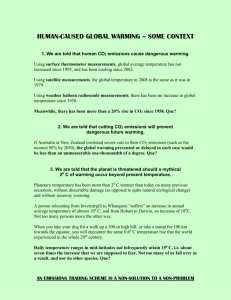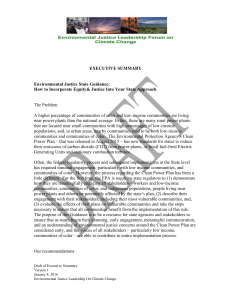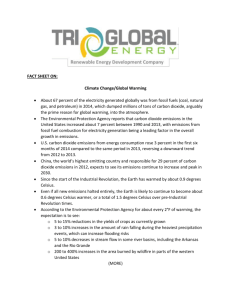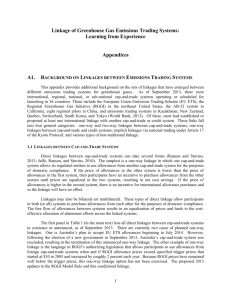Climate Policy as Political Entrepreneurship
advertisement
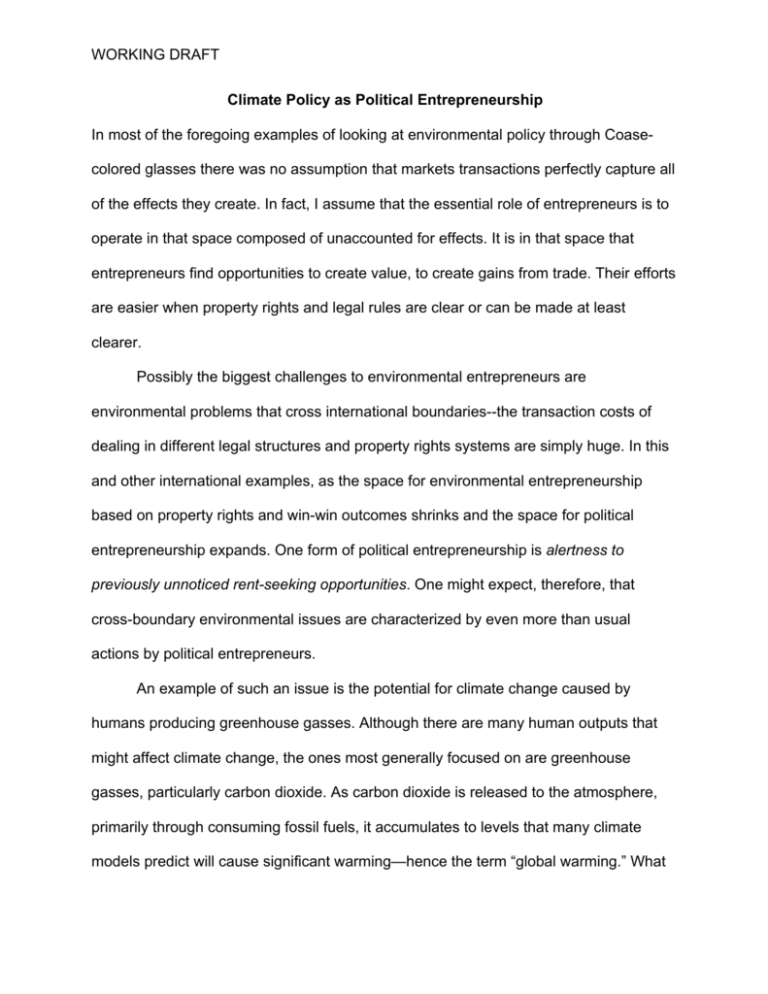
WORKING DRAFT Climate Policy as Political Entrepreneurship In most of the foregoing examples of looking at environmental policy through Coasecolored glasses there was no assumption that markets transactions perfectly capture all of the effects they create. In fact, I assume that the essential role of entrepreneurs is to operate in that space composed of unaccounted for effects. It is in that space that entrepreneurs find opportunities to create value, to create gains from trade. Their efforts are easier when property rights and legal rules are clear or can be made at least clearer. Possibly the biggest challenges to environmental entrepreneurs are environmental problems that cross international boundaries--the transaction costs of dealing in different legal structures and property rights systems are simply huge. In this and other international examples, as the space for environmental entrepreneurship based on property rights and win-win outcomes shrinks and the space for political entrepreneurship expands. One form of political entrepreneurship is alertness to previously unnoticed rent-seeking opportunities. One might expect, therefore, that cross-boundary environmental issues are characterized by even more than usual actions by political entrepreneurs. An example of such an issue is the potential for climate change caused by humans producing greenhouse gasses. Although there are many human outputs that might affect climate change, the ones most generally focused on are greenhouse gasses, particularly carbon dioxide. As carbon dioxide is released to the atmosphere, primarily through consuming fossil fuels, it accumulates to levels that many climate models predict will cause significant warming—hence the term “global warming.” What WORKING DRAFT is more, in terms of effects on atmospheric concentrations, it does not matter whether a ton of carbon dioxide is produced in New York, or Rome, or Beijing because of atmospheric mixing the effects are globalized, not localized. Government officials wanting to “decarbonize” their economies in order to stabilize atmospheric carbon dioxide concentrations are in an n-person prisoner’s dilemma. The world might be better off if all countries agreed to reduce their carbon emissions, but any one country taking major steps to do that without other countries following suit is simply reducing its own wealth and not affecting overall carbon dioxide concentrations in any climatically meaningful way. A country making that choice is taking the “sucker” payoff while other countries free ride. And that “sucker” payoff can be very expensive since there are no easy or inexpensive ways to decarbonize. International agreements complete with reporting and enforcement mechanisms are potential ways to get out of the climate dilemma and the agreement under which most of the developed world has operated is known as the Kyoto Protocol, which was adopted in 1997 and implemented in 2005. By 2010, 191 countries had ratified and signed the agreement, under which 37 developed nations and the European Union member nations committed themselves to reduce greenhouse gasses with the intent of returning to 1990 emissions levels by 2012. Besides putting the responsibility for reducing emissions on developed countries, the Kyoto Protocol committed the developed world to provide billions of dollars of aid to developing countries for emissions control. The developing world is exempt from reducing emissions, including China, India, and Brazil who are among the top-ten emitters of greenhouse gasses— China is the top producer. The one developed country that rejected the Kyoto Protocol WORKING DRAFT is the United States where the U.S. Senate voted 95-0 in 1997 to inform President Clinton that they would not ratify it. The Kyoto agreement to reduce emissions expires in 2012 and Japan, Russia, and Canada announced in 2010 that they would not sign on for a second commitment unless China and poorer nations would agree to make cuts in their own emissions. A public choice analysis of climate change politics predicts that the necessities of electoral politics will drive the climate change policy debate, bureaucrats will use the process to increase budgets and influence, interest groups will seek political rents and use the process to pursue ideological commitments having nothing to do with climate, and voters will remain generally uninformed but sympathetic to “doing something.” It would be surprising if the process operated in any other way. Another surprise would be if the continuing negotiations produce anything that will actually reduce greenhouse gas emissions. The “Conference of Parties” of the United Nations Framework Convention on Climate Change meets annually and the venues are nice, very nice. The list so far includes Berlin, Geneva, Kyoto, Buenos Aires (twice), The Hague, Bonn, Marrakech, New Delhi, Milan, Montreal, Nairobi, Bali, Poznan, Copenhagen, and Cancun. These are continuing rounds of meetings where politicians, bureaucrats, and green activists talk about reaching international accords about what steps all countries will take but these meetings continue to produce little more than an agreement to continue the process another year. Of course there are, as in the 2010 Cancun meetings, non-deals reached for industrialized countries to send billions of dollars per year to developing countries (no source for the funds was identified) and delegates to the meeting pretend WORKING DRAFT the funds will materialize. Country representatives make non-binding pledges on carbon emissions and everyone pretends to believe the pledges will actually be kept. Any new treaty signed will be pointlessly weak or impossible to get through the U.S. Senate. There are winners in this game. Some are the bureaucrats and NGO staff who can justify their budgets and activities as they hold pre-meeting meetings, hire more staff, and circulate new papers on the dangers of climate change. They benefit from having the negotiation process continue, and continue, and continue. Thus, delegates to the meetings claim success at each round of meetings and talk about the long journey toward eventually reaching “a legally binding global climate framework,” as the European Union’s top climate official put it in the 2010 Cancun meeting. Other winners are politicians who need some symbol to show their green constituents. As long as the meetings and promises of reform continue, the politicians can hold them up as successes. The head of the UN Framework Convention on Climate Change quite candidly explained the process when he was asked whether it mattered that Australia had passed its promised emissions trading legislation before the 2009 Copenhagen meetings. He said, “Quite honestly, no. What people care about in the international negotiations is the commitment that a government makes to take on a certain target” (Pielke Jr. 2010, 111). That is, promising to do something is at least as effective as actually doing it. Other potential winners are company executives and hedge fund managers who hope to gain protections and other market advantages, even cartel power, from any of the agreements. If the right agreements are reached the companies will have investments protected and their markets made more secure. No wonder General WORKING DRAFT Electric, Dow Chemical, General Motors and Duke Energy are part of the U.S. Climate Action Partnership, the coalition promoting carbon cap-and-trade in the United States. The Partnership even authored most of the 2010 American Power Act sponsored by Senators John Kerry and Joe Lieberman. One way to understand the continuing process is through the Bootleggers and Baptists metaphor in which environmentalists are the Baptists and companies, trade association, and countries that seek favors under the Protocol’s rules are the bootleggers. Bruce Yandle, the originator of the bootleggers and Baptist metaphor, examined the Kyoto Protocol in 1998 and again in 2010 and noted, Somewhat unexpected coalitions of environmentalists and energy producers still sing together from green hymn books that call for final implementation of the Kyoto-blessed cap-and-trade greenhouse gas controls. However, there is a difference to be observed in how the singers make their music: The interest groups have learned to harmonize better. For example, a U.S. Climate Action Partnership, formed by some leading industrial firms and environmental groups, lobbies strenuously in support of federal cap-and-trade legislation. The industrial players are firms that will gain market share in resulting restructured energy markets. They are green in more ways than one—as in money. Contributions rise for the environmental groups when they sing in harmony. Environmental organizations are also green in more ways than one (Yandle, 2010). Yandle pointed out that under the Kyoto Protocol developed countries make promises and even take actions to decarbonize while China, India, Brazil and others increase their carbon output. He compared that situation to people patching holes in one end of a leaky boat while other people are boring larger holes in the other end. He concluded, “As was the case in 1998, this last observation suggests there is more to the story than emissions control. The themes of favor-seeking and wealth transfers still seem to explain outcomes.” WORKING DRAFT A favorite rent-seeking proposal is to mimic successful regional cap and trade policies by creating a world-wide, carbon cap-and-trade system. The European Union has already created its own cap-and-trade system and the 2010 American Power Act would have created one for the United States if it had passed. Carbon cap-and-trade enthusiasts talk about carbon trading under such a system as if it makes decarbonizing nearly free. Germany’s environment minister claimed, for example, that because of carbon trading Germany could close nuclear plants and replace them with eight to twelve new coal-fired plants. That is, they could close plants that produce no carbon emissions and replace them with ones that generate a lot of carbon emissions. The minister explained that by purchasing offsets, “You can build a hundred coal-fired power plants and don’t have to have higher carbon emissions” (Pielke Jr. 2010, 111. Offsets can come from companies who reduce their own carbon output and, therefore, have credits to sell. Others come from changes in agricultural practices and from rain forest preservation (the forests are carbon sinks). Most offsets are based on claims about what would otherwise have happened. These claims are really just stories about an unknowable future. The “savings” in these stories are turned into marketable carbon credits that European Union producers can purchase in order to exceed legally mandated caps on their emissions. The World Wildlife Fund, for example, hopes to be able to sell some of the $60 billion of offsets that can be gained by offering guarantees to protect large portions of the Brazilian rain forest. The World Wildlife Fund, private foundations, the World Bank, investment fund managers, and the Brazilian government are all involved in lobbying to have the potential offsets in Brazil recognized by the governing body of the UN WORKING DRAFT Framework Convention on Climate Change as tradable credits. The scheme is impressive in its scope as it designates 9.5 million acres of rainforest to be protected from deforestation. These proposed credits will not reduce carbon production since that portion of the rain forest is in no danger of being deforested. Countries like Germany can, however, build many more coal-fired electricity generating plants by purchasing offsets from the rain forest. Thus, if the proposal is approved, WWF and its allies gain a huge financial transfer from carbon emitters while not providing any climate benefit. In fact, carbon emissions will increase. Unintended consequences and even outright fraud exist within the European Union’s cap-and-trade system. Companies in India and China, for example, produce HFC-23, a potent greenhouse gas that is used in the semi-conductor industry and as a refrigerant. Once the European Union allowed companies to pay the Chinese and Indian companies to destroy the gas in exchange for carbon credits, a lively market developed. The unintended consequence is that the carbon credits were worth more than the gas itself, so the producers increased production in order to have more credits to sell (Pielke Jr. 2010, 110). The Chinese government also manipulated the Europeans into providing wind-farm subsidies for wind projects would have been built without the subsidies and for projects that are not even connected to the electrical grid, About onethird of China’s wind turbines are not connected to the grid and were apparently built just for the credits. The HFC-23 and Chinese wind-farm subsidies are two examples among many of how international cap-and-trade programs can and will be manipulated. Do not expect that the problems with cap-and-trade will cause such programs to be replaced with WORKING DRAFT much better policies. The reason is rather simple: there is an increasing potential of billions of dollars to be made whether or not there is any positive effect on emissions. The proposed WWF project, for example, has $60 billion at stake. There are many more projects where powerful bootlegger interests are aligning themselves with environmental Baptists to make themselves better off. Several other problems exist. Even if the developed countries meet their Kyoto pledges there will be no significant effect on global warming. Also, the pledges are simply weak and symbolic. They are weak in that they are not binding; they are just unenforceable promises. They are symbols designed to appease the apparent desires of rationally uninformed voters. They also have politically unworkable conditions attached to them such as the $100 billion in aid to developing countries pledged in Cancun. Since that aid is unlikely to be delivered to developing countries, their leaders will feel free to promote policies that continue to increase carbon output. The even bigger political problem is the fundamental restructuring of the developed world’s economies that would be necessary to decarbonize at promised rates. That is, of course, the desire of many climate change activists who are using climate change as an reason to attempt to transfer wealth from rich to poor nations. German economist and Intergovernmental Panel on Climate Change (IPCC) official Ottmar Eddenhofer, explained prior to the Cancun conference in an interview with the Global Warming Policy Foundation (Potter 2010): First of all, developed countries have basically expropriated the atmosphere of the world community. But one must say clearly that we redistribute de facto the world's wealth by climate policy. Obviously, the owners of coal and oil will not be enthusiastic about this. One has to free oneself from the illusion that international climate policy is environmental policy. This has almost nothing to do with environmental policy anymore, with problems such as deforestation or the ozone WORKING DRAFT hole…Basically it's a big mistake to discuss climate policy separately from the major themes of globalization. The climate summit in Cancun at the end of the month is not a climate conference, but one of the largest economic conferences since the Second World War. In a paper prepared for the Cancun conference Professor Kevin Anderson, Director of the Tyndall Centre for Climate Change Research, said the only way to reduce global emissions enough, while allowing the poor nations to continue to grow, is to halt economic growth in the rich world over the next twenty years. He called for World War II-type rationing of electricity in order to force people to conserve (Gray 2010). Such calls for economic pain run up against what Roger Pielke Jr. in his 2010 book The Climate Fix called “the iron law of climate policy.” The iron law is that economic objectives will have more weight in politics than will environmental objectives. Pielke pointed to a 2009 U.S. poll to illustrate about support for potential increased household costs from a climate bill. The poll found that a majority would accept an annual increase of $80 but that support dropped by half at $175 per year. At an increase of US$770 per year, opponents outnumbered supporters nearly 10 to one. Pielke concludes that any successful policy for decarbonizing economies must provide clear short-term benefits commensurate with the short-term costs. If policies do not coincide with people’s economic goals the policies will fail. Given that current and proposed climate policies run up against the iron law of climate policy and are rent seeking opportunities that provide symbolic (non)agreements, is there a meaningful climate policy? No one has yet developed a way to establish property rights to air or climate and cap and trade policies attempt to create something from nothing—magic carbon credits from promises to not develop. What is left? Many economists suggest a Pigouvian carbon tax. There is even an informal group WORKING DRAFT known as the Pigou Club that supports the U.S. Congress raising taxes on gasoline by 10 cents per year over a decade so that the tax eventually reaches $1 per gallon. The plan is far less complex than the rent-seeking filled cap and trade bills proposed in Congress. The proponents claim it would reduce carbon production, make CAFÉ standards meaningless as people voluntarily seek higher MPG vehicles, put the costs where they should be—on consumers, and could substitute for some income taxes. Of course all the caveats identified earlier in this chapter about not knowing what is the appropriate tax; difficulties of monitoring emissions; unexpected responses by consumers; and the possibility that the tax is wrongheaded, based on incorrect information, or is the hands of ideological zealots still apply. But the rent-seeking and meaningless symbolism that are integral parts of large-scale cap-and-trade systems would be avoided. The most innovative tax idea comes from Ross McKittrick (2008), a professor of economics at Canada’s University of Guelph who specializes in environmental economics and policy analysis. He is skeptical about the claims regarding humancaused climate change and has published many scientific articles on the subject. His proposal, however, ought to appeal to believers and non-believers alike. He proposes a carbon tax that increases or decreases depending on the amount of warming that actually happens in the tropical troposphere, which is the lowest layer of the atmosphere. He suggests the tropical troposphere because climate models predict that is where there will be the first and strongest signals of human-caused global warming. Although he suggests a relatively low tax of about $5 per con of carbon dioxide as a baseline, the tax will increase dramatically along with temperature and would reach WORKING DRAFT $200 per ton by 2100 if some of the climate models are correct. If they are not correct, the tax could fall to zero. There are at least four strongly positive features of McKitrick’s proposal. First, the tax rate starts low enough to not bump up against the iron law of climate policy. Second, no one has to gamble in advance about whether the climate models are correct. Increasing warming produces increased taxes per ton of carbon dioxide produced. Decreasing or no warming reduces the taxes. Third, the tax will cause investors and producers to be forward looking. Today’s tax rate will not affect today’s behavior as much as expectations about future tax obligations. They must plan today for rates ten and twenty years out and they will incorporate expected future taxes into their planning. Fourth, tying tax rates to temperature will create a new market for private-sector climate modeling as firms seek reliable information to build into their planning processes. Competition among climate modelers in this new market would remove climate modeling from a political arena with its short time horizons into a private arena with a large range of time horizons. And actual warming or cooling would be the measure of a good model, not politicians, bureaucrats, or NGO officials.






